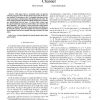Free Online Productivity Tools
i2Speak
i2Symbol
i2OCR
iTex2Img
iWeb2Print
iWeb2Shot
i2Type
iPdf2Split
iPdf2Merge
i2Bopomofo
i2Arabic
i2Style
i2Image
i2PDF
iLatex2Rtf
Sci2ools
TIT
2002
2002
Capacity-achieving sequences for the erasure channel
Abstract-- This paper starts a systematic study of capacityachieving sequences of low-density parity-check codes for the erasure channel. We introduce a class Aof analytic functions and develop a procedure to obtain degree distributions for the codes. We show various properties of this class which will help us to construct new distributions from old ones. We then study certain types of capacity-achieving sequences and introduce new measures for their optimality. For instance, it turns out that the right-regular sequence is capacity-achieving in a much stronger sense than, e.g., the Tornado sequence. This also explains why numerical optimization techniques tend to favor graphs with only one degree of check nodes.
Related Content
| Added | 23 Dec 2010 |
| Updated | 23 Dec 2010 |
| Type | Journal |
| Year | 2002 |
| Where | TIT |
| Authors | P. Oswald, A. Shokrollahi |
Comments (0)

